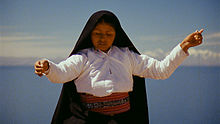Thread Routes
| Thread Routes | |
|---|---|

Kimsooja, Thread Routes - Chapter I, film still, 2010
|
|
| Directed by | Kimsooja |
| Produced by | Kimsooja Studio |
| Cinematography | Immanuel Hick |
|
Release date
|
ongoing |
|
Running time
|
16-25 minutes |
| Country | USA |
| Language | multiple |
Thread Routes is a 16mm film series by artist Kimsooja.
Divided into six chapters, Thread Routes takes place in six different cultural zones around the world. The artist considers her approach to this film as a 'visual poem' and a 'visual anthropology', in that it juxtaposes and presents structural similarities in performative elements of textile culture with the structures in nature, architecture, agriculture and gender relationships in different cultures. These non-descriptive and unnarrative documentary films were conceived after being inspired in Bruges, Belgium, in 2002, by the performative elements of traditional lace making, and the city's architectural structure.
The first chapter, completed in 2010, explores Peruvian weaving culture, and its tight alignment with its landscapes and historic archeological structures. This piece journeys throughout the country, from the Sacred Valley around Cusco, and Machu Picchu, to the Tequila Island villages, forming a non-linear timeline of the tight connection between people and their geographical environment.
Chapter II, which finished filming in the summer of 2011, focused on European lace making actions such as bobbin lace-making from Bruges (Belgium), Lepoglava and Pag (Croatia); industrial lace-making in Calais (France); needle point lace-making by nuns in a monastery in Hvar (Croatia) who use threads from dry aloe leaves; and traditional needlepoint on the small island of Burano (Italy). These scenes are set against representative European architecture such as the Duomo in Milan; the Eiffel Tower in Paris; and the Sedlec Ossuary in Kutna Hora (Czech Republic), which is decorated by human bones and skulls. Local vegetation and flowers overlap with scenes from La Alhambra in Granada (Spain) which, in its detailed and complex decorative Islamic architectural forms, conveys a spatial sensibility and a spiritual dimension that is mirrored in lace-making. The bold, masculine, and power-oriented monumental architectural forms are revealed as similar acts to the delicate, feminine, and ephemeral textile making.
...
Wikipedia
